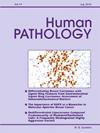多梳组蛋白EZH2免疫染色作为鉴别尿路上皮原位癌与良性病变的诊断工具
IF 2.7
2区 医学
Q2 PATHOLOGY
引用次数: 0
摘要
尿路上皮原位癌(CIS)是一种扁平型非侵袭性尿路上皮癌。适当的诊断CIS是重要的,因为治疗方案取决于诊断。然而,通常很难将CIS与良性病变区分开来,尤其是反应性异型病变。zeste同源物2的增强子(Enhancer of zeste homolog 2, EZH2)是多梳抑制因子复合体2的一个组成部分,通过表观遗传调控基因表达水平参与肿瘤发生。该蛋白在包括尿路上皮癌在内的多种恶性肿瘤中高度表达。我们假设EZH2的免疫染色有助于区分尿路上皮CIS和良性病变。在第一个分析中,我们使用22个手术标本对EZH2和现有的CIS标记物(CK20、p53、Ki67和AMACR/P504S)进行免疫染色,这些标本在形态学上可以很容易地分化为CIS或反应性非典型上皮,因此不需要免疫组织化学。与现有标记物相比,EZH2具有更高的敏感性和相同或更好的特异性。在第二项分析中,我们使用了42例经尿道膀胱肿瘤切除术或活检标本,这些标本仅凭形态学难以诊断,需要对CK20和p53进行免疫染色。与现有标志物相比,EZH2具有较高的敏感性,但特异性略低。在第三个分析中,对27例非反应性非典型上皮良性病变标本进行EZH2免疫染色,包括内翻性乳头状瘤、肾源性腺瘤和腺性膀胱炎。这些病变也显示少量EZH2染色。这些结果表明,EZH2的免疫染色在尿路上皮CIS的诊断中是有用的,特别是作为一种具有优越敏感性的标志物。本文章由计算机程序翻译,如有差异,请以英文原文为准。
Immunostaining for polycomb group protein EZH2 as a diagnostic tool to differentiate urothelial carcinoma in situ from benign lesions
Urothelial carcinoma in situ (CIS) is a flat-type noninvasive urothelial carcinoma. Appropriate diagnosis of CIS is important because treatment options depend on the diagnosis. However, it is often difficult to differentiate CIS from benign lesions, especially reactive atypia. Enhancer of zeste homolog 2 (EZH2) is a component of the polycomb repressor complex 2 that is involved in carcinogenesis by epigenetically regulating gene expression levels. The protein is highly expressed in various malignancies, including urothelial carcinoma. We hypothesized that immunostaining for EZH2 is useful to differentiate urothelial CIS from benign lesions.
In the first analysis, we performed immunostaining for EZH2 and existing CIS markers (CK20, p53, Ki67, and AMACR/P504S) using 22 surgical specimens that could be easily differentiated morphologically as CIS or reactive atypical epithelium, thereby not requiring immunohistochemistry. EZH2 showed higher sensitivity and equal or better specificity than the existing markers. In the second analysis, we used 42 transurethral resection of bladder tumor or biopsy specimens for which diagnoses were difficult to establish based on morphology alone and required immunostaining for CK20 and p53. EZH2 showed higher sensitivity but somewhat lower specificity than the existing markers. In the third analysis, immunostaining for EZH2 was performed using 27 specimens of benign lesions other than reactive atypical epithelium, including inverted papilloma, nephrogenic adenoma, and cystitis glandularis. These lesions also showed minimal EZH2 staining.
These results suggest that immunostaining for EZH2 is useful in the diagnosis of urothelial CIS, particularly as a marker with superior sensitivity.
求助全文
通过发布文献求助,成功后即可免费获取论文全文。
去求助
来源期刊

Human pathology
医学-病理学
CiteScore
5.30
自引率
6.10%
发文量
206
审稿时长
21 days
期刊介绍:
Human Pathology is designed to bring information of clinicopathologic significance to human disease to the laboratory and clinical physician. It presents information drawn from morphologic and clinical laboratory studies with direct relevance to the understanding of human diseases. Papers published concern morphologic and clinicopathologic observations, reviews of diseases, analyses of problems in pathology, significant collections of case material and advances in concepts or techniques of value in the analysis and diagnosis of disease. Theoretical and experimental pathology and molecular biology pertinent to human disease are included. This critical journal is well illustrated with exceptional reproductions of photomicrographs and microscopic anatomy.
 求助内容:
求助内容: 应助结果提醒方式:
应助结果提醒方式:


